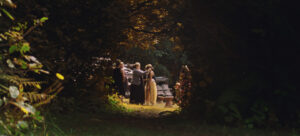SXSW 2022 Is Live: Interview with “Long Line of Ladies” Directors Rayka Zehtabchi and Shaandiin Tome
Written by: Christopher Llewellyn Reed | March 10th, 2022
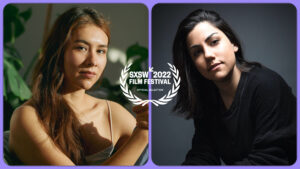
After two years of first turmoil and then purely virtual screenings, the SXSW Film Festival returns to an in-person event in 2022. Sadly, we will not have boots on the ground, though I will cover some films remotely. It is, as always, an exciting lineup, offering (and I quote the official website here): “99 Features including 76 World Premieres, 4 International Premieres, 4 North American Premieres, 2 U.S. Premieres, 13 Texas Premieres, and 111 Short Films. Plus, 24 Music Videos, 11 Episodic Premieres, 6 Episodic Pilots, 29 XR Experience projects (formerly Virtual Cinema), and 19 Title Design entries.” To kick us off over at Film Festival Today, here is an interview I conducted last week with the directors of a terrific short that everyone should check out (tickets available online).
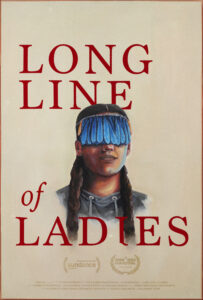
Directors Rayka Zehtabchi (Period. End of Sentence.) and Shaandiin Tome (Mud) premiered their short documentary Long Line of Ladies at the 2022 Sundance Film Festival (where I covered it in our curtain raiser). In the film, they tell the tale of how the Karuk Tribe of northern California resurrected their long-defunct Ihuk, or Flower Dance Ceremony. As an opening title card informs us, “the ceremony was held for generations without interruption until the violence and destruction brought on by the Gold Rush, where Native American girls and women were victims of sexual violence.” Today, it is a joyful affair, and it is a joy to watch the central protagonist prepare for it. May we all celebrate girls becoming women in such a safe and loving environment.
Christopher Llewellyn Reed: You both have directed films either on your own or with other people. What led to the two of you now collaborating with each other on this film?
Rayka Zehtabchi: Well, I think it started with me reaching out to Shaandiin. We had already spoken to Pimm Tripp Allen and her family just a little bit, and they had expressed interest in being a part of the film. And then I came across Shaandiin’s work and just was very impressed with her portfolio. And it was really important to me that there be a driving creative on the project who is indigenous. And with Shaandiin, when we first connected and had a conversation about the project, it just immediately clicked, and she seemed immediately connected and excited about the family and the opportunity to make a project like this.
Shaandiin Tome: Yeah. I got an email from Rayka and we quickly hopped on a Zoom and, I think, spoke for a good while and just got to know each other a little bit. And I think, in that first call, I remember asking some pretty tough questions and that’s usually my test to people to see if they’re willing to collaborate. And I remember Rayka asking me some really tough questions, too. And so we continued those conversations and vulnerability throughout the time that we worked together, and it was really great and it contributed to the project and made the project even that much better.
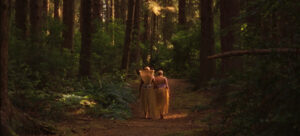
CLR: Now, Shaandiin, you’re indigenous, but you’re from a different part of the country than your subjects. You’re from New Mexico, correct?
ST: Correct. Yeah. Navajo Nation. I’m Diné, which is in New Mexico and Arizona and parts of other places and so I was born here, raised in a suburb of Denver for the most part, but have always had a connection back home–that’s where my grandma is—and then to Albuquerque, as well. So there are similarities amongst tribes throughout the US, but definitely differences and so it was really good to figure out and listen and see those differences and see where things aligned and also where I could learn.
CLR: Speaking of that alignment, does your own culture have anything similar to the Flower Dance Ceremony that we see in the film?
ST: Yeah. We have something called the Kinaalda, which is also when a young girl gets her period for the first time, and I didn’t have mine. I told everybody on the film this story that my family, basically … I remember hearing about it, but they didn’t really tell me too much about it until I got my period for the first time. And at that point, it was a really embarrassing thing because I was at a funeral and I fainted, and it was a whole entire thing and I was so embarrassed that people knew. And quickly after that, my grandma was like, “All right, time to get planning on your ceremony. You’re going to have to make food. You’re going to have to go through this for a period of time. You’re going to have to run.”
And, at that point, I was just like, “That doesn’t sound like something I want to do,” but I wish I would’ve because seeing this movie—or seeing this family in this film—made me wish that I had this type of ceremony when I was a kid, because it would’ve helped form my opinion on that and make me feel proud of where I come from. And I know now a lot better, but I wish there was something like this movie that encouraged me, I guess. And my family definitely does now, but the trajectory of different generations of native people in this country is, unfortunately, sometimes traumatic, sometimes comes from places of assimilation, and there’s a lot of healing going on.
CLR: Rayka, you are Iranian American, right?
RZ: Yes.
CLR: I’ve only seen two of your films, this and Period. End of Sentence., both of which are committed to destigmatizing something as natural as menstruation. Have you pursued that in other films of yours, as well, or is this now a relatively new focus of yours?
RZ: I would say the menstruation focus is in Period. End of Sentence. and Long Line of Ladies. But interestingly enough, Long Line of Ladies is really more about family and community and less specifically … I think the menstruation is the catalyst for the story in some ways, but it’s not necessarily the heartbeat of the film. But I mean, I think if we were to zoom out a little bit, I’ve definitely been, in all of my projects, committed to stories around women and their experiences in the world. So I think that’s definitely a common thread in the projects that I’m interested in doing.
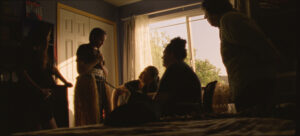
CLR: How did the two of you split the labor on this film? Shaandiin, I noticed that you’ve been a DP [Director of Photography] on a number of previous films, but you were not that on this film, or maybe you shot additional footage but you have a different credited cinematographer. How did you two split the labor? Who did what?
ST: I think we were both very collaborative on everything. I guess there are different approaches for different co-directors, but I think because we’ve worked on our own, as single directors, we both have very passionate ways of going about things. And I think it was lots of communication and tossing things back and forth and just really having our feet in just about everything. It was never a point where it was, “I don’t feel like this is my strong suit, so I’m going to toss this off.” I think we always were questioning and trying to make it a very collaborative process.
RZ: Yeah. It was never a case of deciding beforehand that this is what I’ll take on and this is what you take on. What I’ve realized is we’re both holistic filmmakers. We like the process of filmmaking from start to finish. We like to be involved in everything and help inform the decisions from start to finish. So in the beginning it was a little bit of doing this dance of trying to figure out where you fit or who gravitates towards what. And I think, naturally, that unfolded over time. The more and more you work together, you come in sync and you do that dance together side by side.
CLR: So how did you find your subjects and then approach them about being the subjects of a documentary?
RZ: Well, initially, it was just doing research online and discovering that … well, for me, anyway … there are a lot of native tribes across the country who have coming-of-age ceremonies for young people, not just young women, but there’s all sorts of different types of ceremonies. And then we came across this blog post about specifically the Ihuk ceremony, which is the ceremony of the Karuk tribe of northern California. And the blog post was written by Pimm Allen, who is the subject in the film and Ahty’s mother.
And the blog post was specifically about her older daughter, Ty, having gone through the Ihuk ceremony. So when we connected with Pimm through Facebook and eventually got on a Zoom call with her, I had the first conversation with her and learned that her daughter, Ahty, was actually 13 at the time, had just menstruated for the first time and was about to embark on this journey with her family. And so that opened up the conversation, and I think there was definitely interest on Pimm’s part from the get-go, because I think from a very early stage, Pimm recognized the impact that this kind of film could have on young indigenous audiences.

CLR: It’s a short documentary. Is there additional information about the difficulties that Karuk women faced in bringing back the Flower Dance Ceremony in the 1990s that aren’t covered here? What challenges did they face?
ST: I guess you could go down a rabbit hole of the different traumatic events that created, I guess, the necessity for them to bring back the ceremony. And I guess they say it went dormant more so than it was completely killed off because they definitely had members who knew and could form ways to do it now. I think there’s obviously so much history that can lead up to this moment and also after this moment, and I think we understand that and we wanted to place ourselves in a more emotional space of what it means for a modern-day indigenous family to be living today in these times rather than focusing on the history and the trauma and all of these things that create, I guess, a more ethnographic lens on this family.
And so we really wanted to base ourselves in a visceral feeling that we’re putting into the audience that makes it feel as though they’re with the family and that they maybe don’t fully understand every single point of what it means to put on a ceremony, but they understand the feeling of what it means to be together and what it means to be a community uplifting young women. But I would say that there is a lot of events that led up to this, such as the Gold Rush. They are one of the more Western tribes in the U.S., so they weren’t impacted by colonization until a little bit later on. And so they were able to keep a lot of their traditions alive.
And so that’s a really interesting part of this whole entire trajectory that they’ve had. And just the effort that they’ve put in since Pimm was a young girl and how she wasn’t able to have her ceremony but has seen this resurgence and has seen it in lots of different ceremonies and is trying to build a life and a future. And I think that’s something that is so beautiful and comes across really well in the documentary without necessarily having to understand the details of it all.
RZ: The film doesn’t focus on the history. Maybe that’s a different film, but this one is about healing more than anything. And I think that’s what the family has always wanted, and that’s why they’re so proud of the film. And I think Shaandiin and I had a lot of creative conversations about this, too. It was a question of like, “What if we don’t capture any conflict within this story? Is that enough for the film to stand?” And I think it’s just because we’re conditioned, as storytellers, to think that a story needs conflict in order for people to be invested and to care and ultimately to come away from the film seeing a character that has changed in some way or grown. And we realized, very early on, that this was not that film, it was never going to be that way, and it’s all about the family and the community around Ahty and how what they do is healing not just for them but for many other people around.

CLR: From my perspective, I think you have a nicely built structure, thanks to the ceremony. And I think the advantage of making a short documentary is, perhaps, that these requirements of narrative structure are less exigent because it’s a short film, so we are able to enjoy that shorter moment.
RZ: And in the short form there’s a lot more opportunity to be formless with the filmmaking and to try out different things, and I think that’s always really exciting when working in shorts.
CLR: What kinds of challenges, if any, did you face in terms of access and overcoming people’s potential discomfort of being on camera?
RZ: Well, that was a big part of the journey of the filmmaking. With the family, I think there was always a want and a desire for the family to share, but of course that’s coupled with hesitation, just historically having traditions taken away from them or having them be romanticized in some ways. So there’s a lot of that hesitation throughout the process, and really, it was just us trying to have a back-and-forth, the family being really a part of the process of the storytelling and collaborating, and us learning from them and listening and trying to understand what our boundaries are, what can we capture, what can’t we capture, and more importantly, what is the story that we’re all collectively trying to tell. And we went on this big heart-to-heart and I think, ultimately, creative journey of figuring out what that film is throughout that process.
ST: I think we did a lot of the work up front and we really just tried to understand and listen and explain what we wanted as filmmakers and what we wanted in terms of expression and then also how that meets the needs of the family and how they’re portrayed. And I think there was something really cool there when we got to filming. Nothing that we were even thinking about filming was off limits in that sense because we already had such in-depth conversations beforehand. And then also, the fact that we shot on film—on 16mm—was really helpful with that, because we had to be intentional about things.
And where most documentarians would go in and they would want to shoot everything and then craft the story afterwards, I feel like we already had a pretty well-crafted story. Even when we went in the edit, a lot of the footage was there and it just needed to be placed and it just needed to find its right spot. But for the most part, we could have put different things that we shot within the film, and it still would’ve had a similar emotion to it just because we really tried to do something intentional from the very beginning.
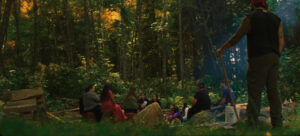
CLR: Did you consider shooting digitally, or did you want that intentionality from the beginning?
Rayka Zehtabchi: I mean, we would go back and forth about it because it’s pretty scary shooting on 16mm film. I mean, it’s expensive and you don’t get to shoot everything. And I think that was definitely a question from the get-go, like, “Is this going to actually hinder us? Is this actually going to disrupt the process?” And really, it didn’t disrupt the process. It just became a necessity for us to rewire our filmmaking brains when we were there and just learn a new workflow. And once we got into the flow, it went hand in hand with this idea of being intentional.
And at least for me personally, this film, this whole process and journey has taught me a new way of looking at filmmaking, a more responsible, more collaborative way of filmmaking that I hope to replicate in the future on other projects. And I think when you give yourself limitations, creatively, I’ve noticed that it only helps. I really do think it might complicate the process a little bit more, but I think it really did help result in a more beautiful, thoughtful, intimate, and intentional film.
CLR: You have both made, up to this point, only shorts. Are either of you planning a feature in the future? Not that features are inherently better …
RZ: I am. I’m taking my time, though. I think it’s funny, I talk about this with people. There’s such a pressure, I think, to dive into features right away when you’re fresh out of film school and it feels like that’s the legitimate path to take. And I feel really grateful to have had the opportunity to work in shorts. And I think it’s something that I’ll do forever even as I eventually make a transition into features, just because I love the short medium. I think it’s more accessible to people a lot of the times and really is just an opportunity to explore different styles, different themes, and your voice as a storyteller. So I definitely look to the future with an eventual feature, but shorts are never going to be out of the picture.
ST: I feel similarly. Shorts, to me—even just watching shorts programs—are so much more expressive and artistic and, I guess, just a part of somebody. And I think that’s really cool. I plan to make a feature someday. I also don’t want to mess up because I know you only have, like, one first feature, so I’m also taking my time and wanting to do it right and not be rushed. And I’ve been approached to direct other people’s features and all of that stuff. And I just want to … I want to be a writer and director, so I think I want to do that for myself for the first one.
CLR: I wish you both good luck with whatever that first feature project will be. Thank you for making this really powerful short.
RZ: Thanks, Chris!
ST: Thanks so much!
